Deaths from drinking surged during pandemic: CDC

There were about 488 deaths per day from excessive drinking in the U.S. during the height of the pandemic from 2020 to 2021, part of a surge in alcohol-related fatalities seen over five years, the Centers for Disease Control and Prevention reported.
Why it matters: The increased availability of alcohol carryout and home deliveries may been a factor, along with stress, social isolation and general delays seeking medical care, officials said.
- Deaths linked to excessive drinking rose about 35% among females and about 27% among males during the five-year period.
What they found: The CDC and Canadian Institute for Substance Use Research looked at 58 conditions directly or indirectly connected to excessive alcohol use.
- The average annual number of deaths rose about 29%, from 137,927 during 2016–2017 to 178,307 during 2020–2021.
- That broke down to annual increases of more than 25,000 among males and more than 15,000 among females.
- Death rates for women were highest from heart disease and stroke, while most of the male deaths were attributable to chronic conditions from alcohol use.
Between the lines: U.S. deaths and emergency room visits linked to excessive alcohol use have been trending upward for two decades.
- One recent study found that 1 in 8 total deaths among U.S. adults ages 20–64 between 2015 and 2019 were from too much drinking.
- But shifting behaviors and attitudes in the COVID era likely exacerbated the problem, with the prevalence of binge drinking among adults aged 35–50 years higher in 2022 than in any other year during the previous decade.
While alcohol-related deaths have historically been higher among men than women, recent trends suggest a narrowing of this gap, a 2023 study in JAMA found.
- Women tend to have a higher percentage of body fat and a lower percentage of body water, resulting in higher blood alcohol concentrations and potentially increasing complications, the study noted.
- Hormonal fluctuations and other factors can leave women with alcohol use disorder facing a higher risk of developing liver diseases, circulatory disorders, breast cancer, fertility problems and early menopause.
What we're watching: The CDC said the spike in deaths could give states and localities reason to reduce the availability of alcohol through steps like raising taxes or lowering the number of establishments selling alcohol.
- "Making alcohol less accessible and less available by having fewer places that sell it, or spreading out the number of places that are selling alcohol can help to create environments that support people's choice to drink less," study author Marissa Esser told CBS News.